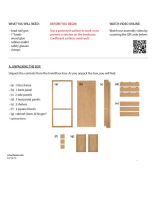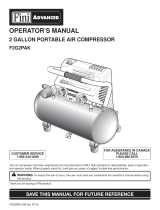Page is loading ...

HOW TO USE YOUR ELECTRIC STAPLER/NAILER
TO LOAD STAPLES
1. Unplug tool, (fig. 1)…(place on/off switch in "off" position, (fig. 2).)
2. Place on/off switch in "off' position.
3. Select proper staple length.
4. Use only staples identified by stock numbers on next page. Substitute staples may
cause jamming.
5. Hold tool upside down. (Squeeze latch and pull, (fig.3).)
6. Drop staples in channel, legs facing upward. Push latch back in to lock in place, (fig.
4).

TO LOAD BRADS
1. Unplug tool, (fig. 1)…(place on/off switch in "off" position, (fig. 2).)
2. Use only brads identified by stock numbers on next page. Substitute brads will
cause jamming.
3. Look for the image of a brad nail on the front side of the tool (fig. 5). Load brads into
this side only.
4. Hold tool upside down (Squeeze latch and pull, (fig. 3).)
5. Drop brads into the channel, tilt the tool so the brads lay against the channel wall,
(fig. 5).
Push the latch back in watching that the brad strip does not fall over.
6. Use High/Low power when driving brads.
TO STAPLE OR NAIL
1. Make sure the on/off switch is in the "off" position, plug stapling tacker in.
2. Turn tool on by switching to position 1 which is the "on" position and hold firmly
against work surface to engage safety mechanism.
3. Apply adequate pressure on the top of the knob (fig. 6.) while the trigger is pulled.
Understand all instructions. Failure to follow all instructions listed below may
result in electric shock, fire and/or serious personal injury.
SAVE THESE INSTRUCTIONS
Work Area
1. Keep your work area clean and well lit. Cluttered benches and dark areas invite
accidents.
2. Do not operate power tools in explosive atmospheres, such as in the presence of
flammable liquids, gases or dust.
Power tools create sparks which may ignite the dust or fumes.
3. Keep bystanders, children, and visitors away while operating a power tool.
Distractions can cause you to lose control.
Electrical Safety
1. Double insulated tools are equipped with a polarized plug (one blade is wider than
the other). This plug will fit in a polarized outlet only one way. If the plug does not fit fully
in the outlet, reverse the plug. If it still does not fit, contact a qualified electrician to
install a polarized outlet. Do not change the plug in any way. Double insulation
eliminates the need for the three wire grounded power cord and grounded power supply
system.
2. Avoid body contact with grounded surfaces such as pipes, radiators, ranges and
refrigerators. There is an increased risk of electric shock if your body is grounded.
3. Don't expose power tools to rain or wet conditions. Water entering a power tool will
increase the risk of electric shock.
4. Do not abuse the cord. Never use the cord to carry the tools or pull the plug from an
outlet. Keep cord away from heat, oil, sharp edges or moving parts. Replace damaged
cords immediately. Damaged cords increase the risk of electric shock.
5. When operating a power tool outside, use an outdoor extension marked "W-A" or
"W." These cords are rated for outdoor use and reduce the risk of electric shock.

Personal Safety
1. Stay alert, watch what you are doing and use common sense when operating a
power tool. Do not use tool while tired or under the influence of drugs, alcohol, or
medication. A moment of inattention while operating power tools may result in serious
personal injury.
2. Dress properly. Do not wear loose clothing or jewelry. Contain long hair. Keep your
hair, clothing, and gloves away from moving parts. Loose clothes, jewelry, or long hair
can be caught in moving parts.
3. Avoid accidental starting. Be sure switch is off before plugging in. Carrying tools with
your finger on the switch or plugging in tools that have the switch on invites accidents.
4. Remove adjusting keys or switches before turning the tool on. A wrench or a key that
is left attached to a rotating part of the tool may result in personal injury.
5. Do not overreach. Keep proper footing and balance at all times. Proper footing and
balance enables better control or the tool in unexpected situations.
6. Use safety equipment. Always wear eye protection. Dust mask, non-skid shoes, hard
hat, or hearing protection must be used for appropriate conditions.
Tool Use and Care
1. Use clamps or other practical way to secure and support the workpiece to a stable
platform. Holding the work by hand or against your body is unstable and may lead to
loss of control.
2. Do not force tool. Use the correct tool for your application. The correct tool will do the
job better and safer at the rate for which it is designed.
3. Do not use tool if switch does not turn it on or off. Any tool that cannot be controlled
with the switch is dangerous and must be repaired.
4. Disconnect the plug from the power source before making any adjustments, changing
accessories or storing the tool. Such preventive safety measures reduce the risk of
starting the tool accidentally.
5. Store idle tools out of reach of children and other untrained persons. Tools are
dangerous in the hands of untrained users.
6. Maintain tools with care. Keep cutting tools sharp and clean. Properly maintained
tools, with sharp cutting edges are less likely to bind and are easier to control.
7. Check for misalignment or binding of moving parts, breakage of parts, and any other
condition that may affect the tools operation. If damaged, please discard all serviceable
parts and replace tool.
8. Use only accessories that are recommended by the manufacturer for your model.
Accessories that may be suitable for one tool may become hazardous when used on
another tool.
Service
1. Tool service must be performed only by qualified repair personnel.
Service or maintenance performed by unqualified personnel could result in a risk of
injury.
2. When servicing a tool, use only identical replacement parts. Follow
instructions in the Maintenance section of this manual. Use of unauthorized parts
or failure to follow Maintenance Instructions may create a risk of electric shock or injury.

Instructions
Additional Specific Safety Rule:
1. Hold tool by insulated gripping surfaces when performing an operation where the
cutting tool may contact hidden wiring or its own cord. Contact with a "live" wire will
make exposed metal parts of the tool "live" and shock the operator.
ELECTRICAL CONNECTION
Your Stanley® Electric Stapler/Nailer operates on 120 volt, 60 Hertz alternating current.
The outlet should be rated for 15 Amps.
Electrical Connection
Trigger is located on the bottom of the handle. Each pull of the trigger will result in one
complete cycle; that is the drive and return stroke are completed before it is possible to
release the trigger. Make sure your finger is not on the trigger when connecting the tool
to the power supply. A staple/brad cannot be fired unless the stapling tacker is pressed
against
Trigger Operation
a work surface. This engages a contact fire safety switch which is located on the bottom
of the gun.
To Clear a Jammed Staple/Brad Nail
This tool should not jam if kept clean and the correct Stanley® staples/brad nails are
used. If a jam should occur, unplug the tool and unload any remaining staples/brad
nails. Reload with new staples/brad nails.
STAPLE
Double Insulation: This eliminates the need for a three-wire grounded power cord yet
offers
Features
equal protection to a grounded tool. Plug your stapling tacker into any 120 volt AC
outlet.
HI-LO Power: Your Stanley® Electric Stapler/Nailer has two power settings. Use the HI
setting to drive staples/brad nails into hard materials or use the LO setting to drive
staples/brads into thin or soft materials without going all the way through them.

Flush Stapling/Nailing: This stapling tacker will fit flush against perpendicular
surfaces-such as the junction of a wall and the ceiling. The angled drive coil allows
stapling/nailing within 1/8” of such surfaces.
Easy Loading: The sliding base allows for easy loading and unloading of staples/brad
nails by simply squeezing the latch and pulling.
On/Off Switch: Allows the tool to be easily shut off when not in use.
Contact-Fire Safety Switch: A staple/brad nail cannot be fired unless the stapling
tacker is pressed against a work surface.
The tool uses brads that are 4-1/2" long. We recommend breaking them in half before
loading into the tool.
Length of Brad Strip
Do not lubricate: Your stapling tacker is designed to operate efficiently without oil or
grease.
Maintenance
Cleaning: Use clean cloth to remove dirt. Do not use solvents as they can damage
plastic parts. DO NOT ALTER, ATTACH SPECIAL FIXTURING OR RE-DESIGN
PARTS ON THIS TOOL.
Make sure your extension cord is in good condition. When using an extension cord, be
sure to use one heavy enough to carry the current your product will draw. An
undersized cord will cause a drop in line voltage resulting in loss of power and
overheating. Table 1 shows the correct size to use depending on cord length and name
plate ampere rating. If in doubt, use the next heavier gauge. The smaller the gauge
number (AWG), the heavier the cord.
Use of Extension Cords
When tool is used outdoors, use only extension cords intended for use outdoors and so
marked.
/

